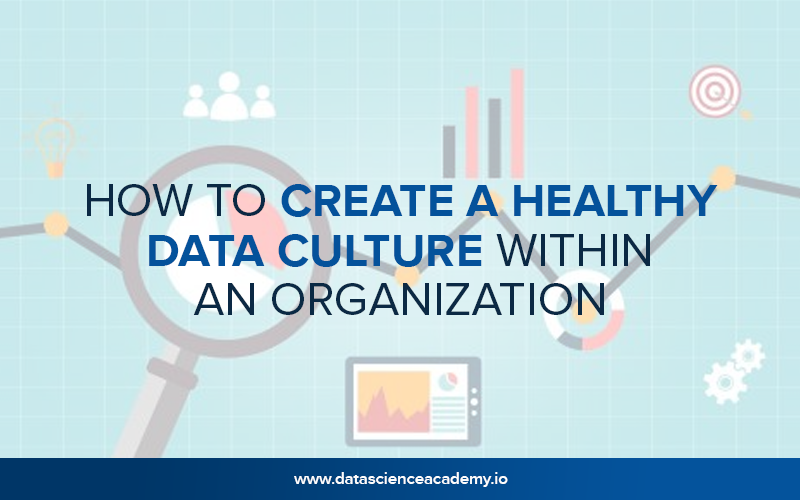
How to Create a Healthy Data Culture Within An Organization
In this era, for companies - the ability to make informed decisions is more crucial and critical than ever. The data no longer relate to observations but encourage organizations to ask critical questions. On the other hand, it has the power to reshape companies, create new sources of revenue, and create a business model that protects the future. Today, the culture is data-driven communities is set by data-driven individuals who obtained Big data certification through all departments and levels. In these cultures, everyone has the right to critically use data, make decisions, and initiate conversations, instead of blocking them.
However, for organizations that have not been able to promote this cultural change or have not invested in improving staff data capacity, progress has been slow. At the same time, competitors continue to democratize data and everyone’s ability to access, understand, and communicate with them. Employees are selected and have the right to make informed decisions to keep the company on track. There are no blocks in obtaining information, and there is no uncertainty in the management base that teams have data that supports this culture.
Steps to Creating a Data-Driven Business Culture
Unfortunately, creating a data culture - is not as easy as asking employees to use a complex platform. Instead, some initiatives can boost the internal data community.
Include Data Collection in Your Goal and Tasks
Data policy must be properly integrated into business policies. Companies should no longer work on general missions, and the days of general transparency and credibility are over. Instead, project statements must be solid and shape desirable business behavior. These goals must be feasible, relevant, and accountable to integrate well with departmental goals. Also, set goals for shared data, such as adopting a definition of business metrics for government bodies to improve governance.
Increase Your Internal Data Community
The data culture of an organization does not become a community, but an individual. For a data culture to work, you need to encourage the hiring manager to include statements like “data-based” in job descriptions so that the company can reach people who now have that mindset. And it’s just as important to use this gold mine of knowledgeable colleagues who are already full of food in every department!
Try to build your league by recognizing company employees who are data lovers. Having a league also means you have a diverse team in many companies to help you use interdisciplinary data-based methods. Collaborate with them to create relevant resources and organize interactive sessions according to their areas of work, different skills, and different levels of participation.
Create an Accessible Dashboard
Indicators such as revenue, profit, number of customers can generate good conversations and help define data as a concept. Adding some of these elements to an entire company dashboard can engage users and ultimately promote a data-driven culture. This way, you will be aware of other future projects of the company, and you will see if you can work with them to bring more information to your company. To eliminate the fear of data and create a dashboard with fun benchmarks, people are happy to follow it. You can add data on volunteer time relative to the annual target, the number of varieties the department lost this year, or the use of snacks per quarter.
Get Engaged
Data can be a daunting word for those who don’t know it. To eliminate the fear of data factor, you should consider introducing some fun metrics that people enjoy. You can add data on volunteer time to reach your annual goal, the number of adapters lost by departments this year. One way to increase adoption is to capture activities and create healthy competition between departments. For a successful data platform to work positively there must be a solid data-driven culture. This approach creates a workforce and allows employees to be part of the internal data society.
The Role of Organizational Culture in Company Success
The researchers pointed out that the development of a positive work culture leads to an improvement in the work of the organization. The planning culture is a crucial deciding factor in planning. A researcher also pointed out that organizational culture positively or negatively affects an organization’s success. In other empirical studies, the effectiveness of organizational culture is influenced by 46% of company profits.
However, culture planning can affect performance because changes are a long time frame that shows the impact of culture on financial results. Company leaders use the term organizational performance to express actions and results taken in an organization to show the performance of an organization that reflects performance. When business leaders use organizational performance to express activities, organizational effectiveness is the ability of an organization to perform its functions by its members. Managers may recommend high, medium, or low ratings based on standards.
When business leaders use organizational performance to express results, organizational performance is the result or performance of the organization, including productivity, profitability, and growth. The result can be measured according to its goals. Factors include employee empowerment, external attention, interdepartmental cooperation, personnel policy, and performance improvement trends.
Creating a Data-Driven Culture Requires Patience
Starting a journey with a large amount of data can be daunting, but it’s important to start with a solid foundation. Your controlled culture doesn’t happen overnight with the purchase of a new technology system or the command of senior management. Because of the pressure to improve maintenance and reduce costs, it is tempting to bypass the efforts needed to promote a data-driven culture and look for innovative technological solutions instead.
Building technical infrastructure is indeed relatively easy. The challenge is to create an interactive culture that integrates data into day-to-day decision-making. Switching to this culture will require radical changes in your company, but the first steps can be simple: determine the strength of your culture today. Even if your organization is not yet ready to launch a comprehensive data culture program, it can begin to lay the groundwork for core competencies to create a data-based culture.
